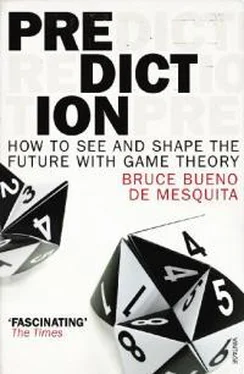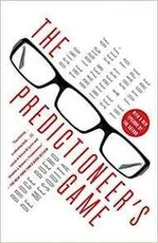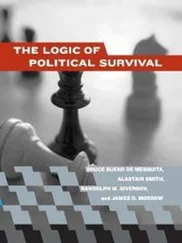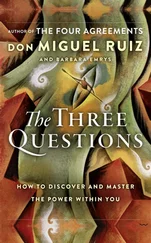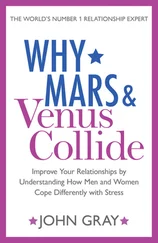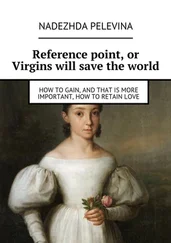The very thick, dark lines in the figure show what the plans of action were for the French buyer and the German seller. There is a plan of action for every contingency in this game. One aspect of the plan of action on the part of the executives in Heidelberg was to say nein to a big-money offer that required them to move to Paris. This never happened, exactly because the French bankers asked the right “what if” question. They asked, What happens if we make a big offer that is tied to a move to Paris, and what happens if we make a more modest money offer that allows the German bank’s management to stay in Heidelberg? Big money in Paris, as we see with the thick, dark lines, gets nein and less money in Heidelberg encourages the seller to say jawohl . Rather than not make the deal at all, the French chose the second-best outcome from their point of view. They made the deal that allowed the German management to stay put for five years. The French wisely put themselves in their German counterparts’ shoes and acted accordingly.
By thinking about the strategic interplay between themselves and the German executives, the French figured out how to make a deal they wanted. They concentrated on the all-important question, “What will the Germans do if we insist they move to Paris?” No one actually moved to Paris. Historians don’t usually ask questions about things that did not happen, so they would probably overlook the consequences of an offer that insisted the German management relocate to France. They might even wonder why the Germans sold so cheaply. In the end, the Germans stayed in Heidelberg.
Why should we care about their moving to Paris when in fact they didn’t? The reason they stayed in Heidelberg while agreeing to the merger is precisely because of what would have happened had the French insisted on moving them to France: no deal would have been struck, and so there would have been no acquisition for anyone to study.
The two games I have illustrated in the preceding pages are very simple. They involve only two players, and each game has only one possible rational pair of strategies leading to an equilibrium result. Even a simple two-player game, however, can involve more than one set of sensible plans of action that lead to different possible ends of the game. We’ll solve an example of such a game in the last chapter. Of course, with more players and more choices of actions, many complicated games involve the possibility of many different strategies and many different outcomes. Part of my task as a consultant is to work out how to get players to select strategies that are more beneficial for my client than some other way of playing the game. That’s where trying to shape information, beliefs, and even the game itself become crucial, and in this next section I’d like to show you just what I mean.
WANT TO BE A CEO?
As we all know, great jobs are getting harder to come by, and reaching the top is as competitive as ever. Merit may be necessary, but, as many of us can attest, it’s unlikely to be sufficient. There are, after all, many more well-qualified people than there are high-level jobs to fill.
That being said, even if you’ve managed to mask or overcome your personal limitations and have been blessed with great timing and good luck such that you now find yourself in the rarefied air of the boardroom, there’s something worth knowing that might have escaped you, something that might still prevent you from grabbing that cherished top spot: the selection process.
That’s right, understanding and shaping the process by which a CEO or other leaders are chosen can tip the competition in your favor. It’s funny that few of us pay much attention, in a strategic sense, to something as prosaic as how votes are counted, whether in the boardroom or national elections. And yet the method used to translate what people want into what they get can turn a losing candidacy into a winning one. 3
When I talk about shaping outcomes based on voting, I don’t mean anything like miscounting or cheating. I don’t mean relying on hanging chads or anything like that. I’m just thinking about the many regular, commonly used ways of arriving at a choice based on what voters or shareholders or board members want.
Few board members or shareholders pause to think about how the votes are going to be counted when they select a new CEO. Hardly anyone asks whether it really matters if we require a candidate to get a majority or a plurality; if we count just votes for people’s first choice or we allow them to express their first and second (or even more) preferences; if in decisions with many candidates we vote on all of them at once or we pair them up in head-to-head contests. And yet you can bet your bottom dollar that these decisions really can change the results.
Just think back to the hotly contested 2008 Democratic Party primaries. The Democrats allocated delegates from each state roughly proportionally to the candidates based on their share of the popular vote in each primary. Barack Obama won a majority of delegates that way, and was ultimately elected president. If the Democrats had used the Republicans’ winner-take-all rule in each primary, Hillary Clinton would have won enough delegates to be the nominee, and she too probably would have gone on to beat John McCain. That’s a pretty big consequence of a seemingly inconsequential rule.
There is, of course, no right way to count votes. Every method has advantages and disadvantages. So we might as well use voting rules when we can to help the candidates we favor. Generally we don’t have the opportunity to change how votes are counted in government elections, but we sure do when it comes to corporate decisions.
In fact, I’ve twice used the range of boardroom voting procedures to help shape corporate choices of CEOs. Once the effort was entirely successful, and the second time, well, the candidate that my partner and I helped rose from obscurity to be treated as a very serious candidate. He ultimately lost, but he did so much better than anyone expected that he was quickly hired away from his company to become the CEO of a different firm—and he was a great success there.
How was the CEO selection process modeled? Let’s take a look at my first experience on this front (it has the nice feature that even the person who was chosen as CEO didn’t know—and probably still does not know—how he won). Here’s what happened:
The retiring CEO of the company in question—certainly it must be obvious that there is a need for anonymity here—didn’t have strong feelings about who he wanted to replace him. He did, however, have very strong feelings about who he did not want to replace him, and it just so happens that the person he didn’t want was the leading candidate for succession. The retiring CEO truly despised this person, who had been his nemesis for many years, and he hired me in secret to help engineer the CEO selection. The modeling job: figure out how to beat the detested front-runner.
As with any analysis, the first step was to figure out just what were the real issues that had to be resolved. In this case, the big questions were simple enough. They required working out who the prospective candidates were and how they stacked up against each other. Let’s call the candidates Larry, Moe, Curly, Mutt, and Jeff—with Mutt being the guy to beat.
The problem was best analyzed with a bunch of beauty contests. Each beauty contest asked how the stakeholders with a say in selecting the CEO felt about Larry vs. Moe, Larry vs. Curly, Larry vs. Mutt, Larry vs. Jeff, Moe vs. Curly, and so forth.
Once the issues—the beauty contests—are specified, we need to know each stakeholder’s position, or which candidate he or she favors in each head-to-head contest, and by how much. (I will go into further detail in subsequent chapters as to the particular methodology behind these assessments.)
Читать дальше
